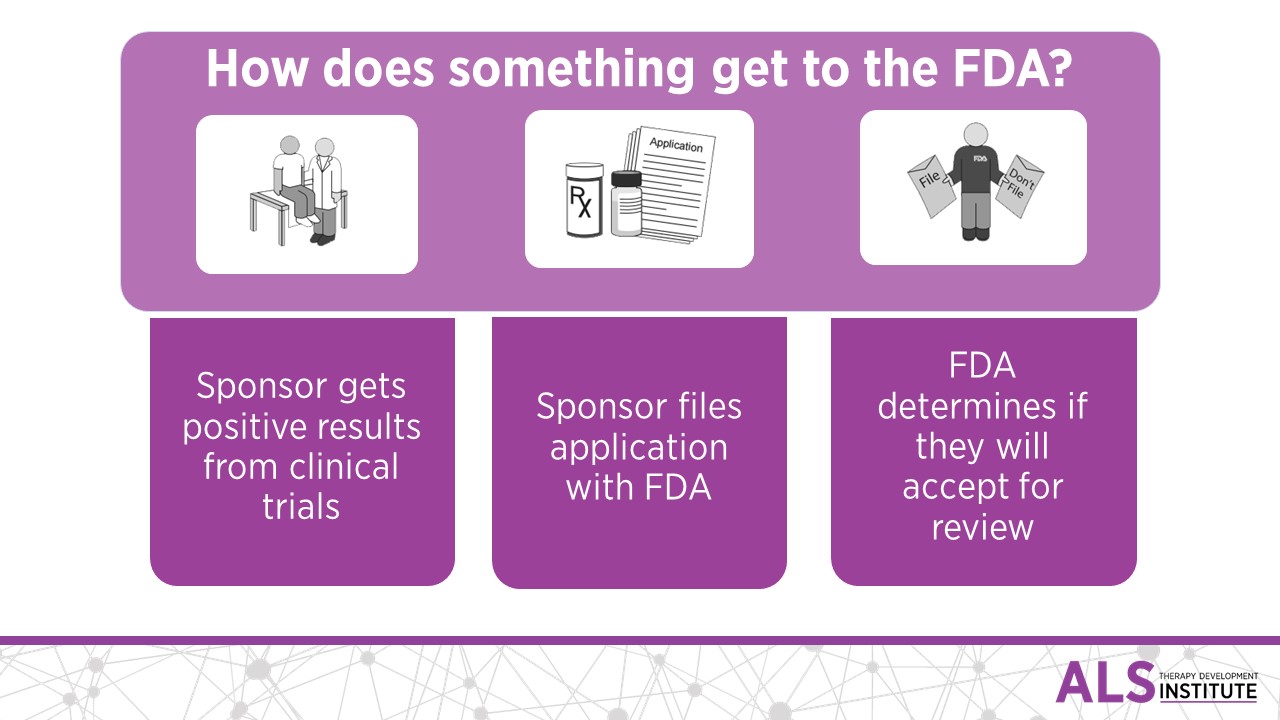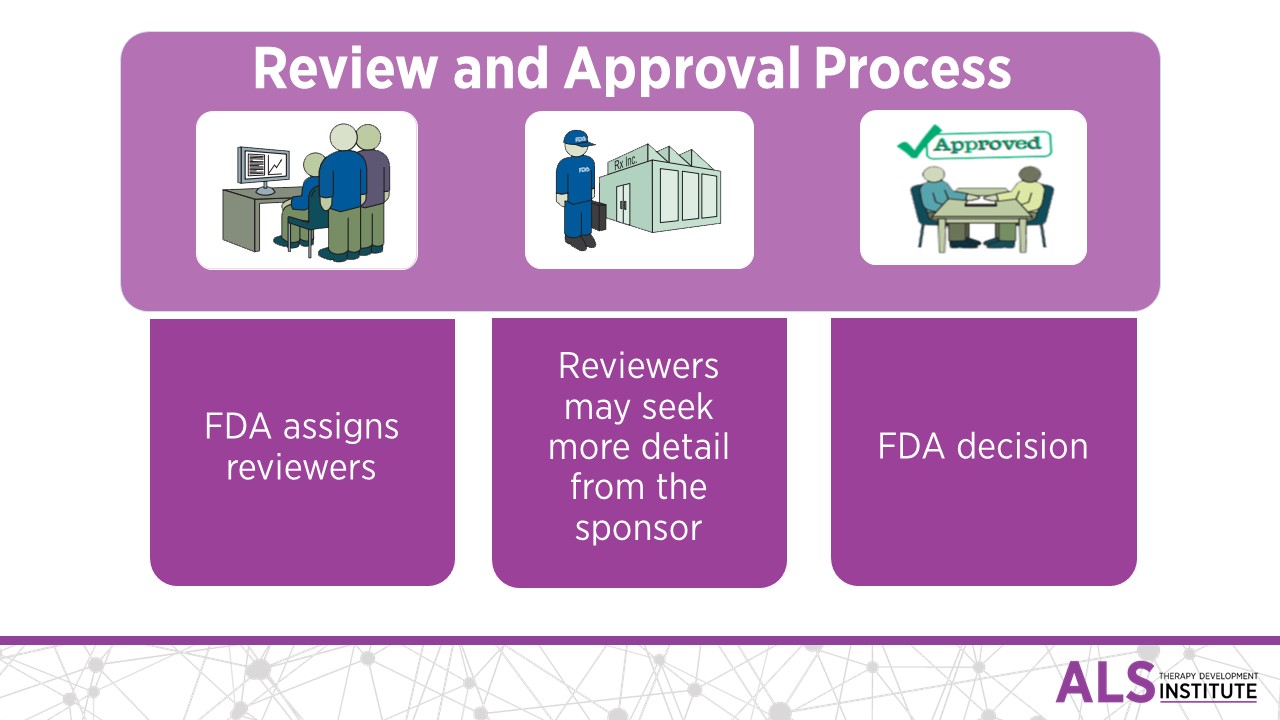In the days and weeks following the approval of Radicava, there have been a lot of questions surrounding the role of the FDA and how drugs are approved for market in the US. On May 17, 2017 we held a webinar, which can be viewed here, to talk about the FDA’s role in the drug approval process in the United States. The webinar recording is about 60 minutes long, the following being only a brief summary.
Who is the FDA and what role do they play in the drug approval process?
The Food and Drug Administration (FDA) is the agency charged by the US government to ensure that public health is protected through the control of food and drugs marketed in the United States. Within the FDA is the Center for Drug Evaluation and Research (CDER) who are responsible for reviewing new drug applications submitted for marketing approval.
The FDA and CDER are in place to ensure that companies are marketing drugs that are safe, effective and are manufactured consistently. In order to do this, the FDA reviews research done on a drug, examines the proposed labeling of the drug and inspects the facility in which the drug is to be manufactured.
It is important to note that most insurance companies, including Medicare, will not cover a drug under their health insurance policies unless it has received approval from the FDA. When a drug is approved by the FDA, this gives the company permission to market their product in the United States. It is up to the sponsoring company whether or not they decide to pursue marketing approval in other jurisdictions.
How does a drug get to the FDA for review?
The best organizations developing potential new medicine are in regular contact with the FDA. In fact, the FDA requires or encourages contact at all stages of development, starting early on when company sees signs that a drug in preclinical development may have potential to be a clinical trial candidate.
Following successful signs from preclinical testing, these meetings are called pre-IND (investigational new drug application) meetings, and are a way for representatives from company and the FDA to speak with each other about the new drug, the disease being targeted and talk about clinical trial designs. The successful filing of an IND with the FDA is required to conduct clinical trials on new drugs in the US.
After that, the company and the FDA will speak before and after each phase 1, 2 or 3 clinical trial is completed. Typically, one of the most important conversations follows successful phase 2 clinical trials; where the plans for a pivotal phase 3 study will be discussed. This meeting is crucial because it enables representatives from the company to educate the FDA on any unique ways in which they will be measuring for efficacy in the clinical trial, among other things. It is usually around this time that the FDA and the company will discuss any potential for the drug to be approved before a phase 3 trial, this is called accelerated approval.
 If accelerated approval is not sought and awarded, additional trials commence and are completed. The company sponsoring those trials typically submits a New Drug Application (NDA) following a successful phase 3 trial. The application must contain information on the company’s preclinical and clinical data and how they will manufacture, package and label and market the treatment.
If accelerated approval is not sought and awarded, additional trials commence and are completed. The company sponsoring those trials typically submits a New Drug Application (NDA) following a successful phase 3 trial. The application must contain information on the company’s preclinical and clinical data and how they will manufacture, package and label and market the treatment.
The FDA has 60 days from when the NDA is submitted to decide whether or not to accept the application for review. If the application is accepted, the FDA will also decide at this time whether the review that follows will take up to six months (“Priority”) or ten months (“Standard”).
The Review and Marketing Authorization ("Approval") Process
If the FDA decides to file the application for review, they will then assign a team of reviewers made up of both internal and external committees with relevant professional backgrounds in fields such as medicine, pharmacology, biology and chemistry. They will then try to determine the following:
- Is the drug safe and effective?
- Do the benefits of the drug outweigh the risks?
- What is the proposed labeling and packaging?
- Will the drug maintain its quality, strength and purity through manufacturing, distribution, etc?
 When making these determinations, the reviewers may seek more detail from the sponsor and organizations representing patients to determine whether they will recommend the drug for approval. The recommendation of the review team is not binding; the FDA director will always have the final say on whether a drug is approved or not. The FDA will then notify the company on whether or not their drug has been approved. This is usually followed by a press release from the FDA on the decision. You can see a list of press releases from the FDA here.
When making these determinations, the reviewers may seek more detail from the sponsor and organizations representing patients to determine whether they will recommend the drug for approval. The recommendation of the review team is not binding; the FDA director will always have the final say on whether a drug is approved or not. The FDA will then notify the company on whether or not their drug has been approved. This is usually followed by a press release from the FDA on the decision. You can see a list of press releases from the FDA here.
Post approval
If a drug is approved, a company will make their own announcement and will usually begin negotiating with health insurers, working on manufacturing and distribution channels and educating physicians and other interest groups on their product. Usually the drug maker will also make an announcement as to when they believe they can start shipping their drug to pharmacies that may fill prescriptions. Many factors, such as those named earlier in this paragraph, may influence the time between drug approval and drug availability.
It is important to note that that FDA approval allows a company to market a drug, it does not require medical doctors to write prescriptions. It is up to the individual doctor as to whether or not they believe their patient may benefit from the medication and up to the patient as to whether or not they will accept the recommended treatment. It is also not mandatory for a health insurer to cover a medication under their policy. We recommend that people with ALS speak with their doctor and insurer if they have questions about getting a prescription or coverage for any treatment.
It is up to each heath insurance company whether or not they will cover a drug approved by the FDA under each of their policies. In some cases, the company that makes the drug may offer discounts, rebates or other assistance programs to people who are prescribed the medication.
What about Expanded Access and Right to Try?
Compassionate Use or Expanded Access is the use of an medical product outside of the typical clinical trial process. It is usually requested when patient enrollment in a clinical trial is not possible and essentially requires a single-patient IND. As such, the patient seeking the treatment must enter into an agreement with a willing doctor and a willing drug maker to access a drug experimentally. Each single patient compassionate use application is considered on a case by case basis at the FDA. A summary of the treatment impact in the patient must be reported to the FDA and this information could impact ongoing trials and FDA reviews.
Right to try laws are state laws that are created to allow terminally ill patients to try experimental therapies that have completed phase 1 testing, in most cases. Accessing experimental drugs is a challenge since it requires the patient, their doctor, their health insurer and the sponsoring company to agree to the terms of treatment. To our knowledge, no one has accessed a drug under any right to try legislation in the US. ALS TDI has released statements in the past, outlining our stance. They can be found here (2014) and here (2016).
What can you do to help?
The pathway to FDA approval in the United States can be a complicated and lengthy process but there are ways everyone can help. Most importantly, involvement in clinical trials is vital - without participants willing to take part in clinical trials, drugs will not receive approval (some trials are even accepting healthy volunteers!). You can find a list of ongoing trials in ALS, along with their inclusion and exclusion criteria here.
If you have any questions or concerns on this topic or feel that we left anything out of our discussion, let us know by emailing us at letstalk@als.net.
Resources: